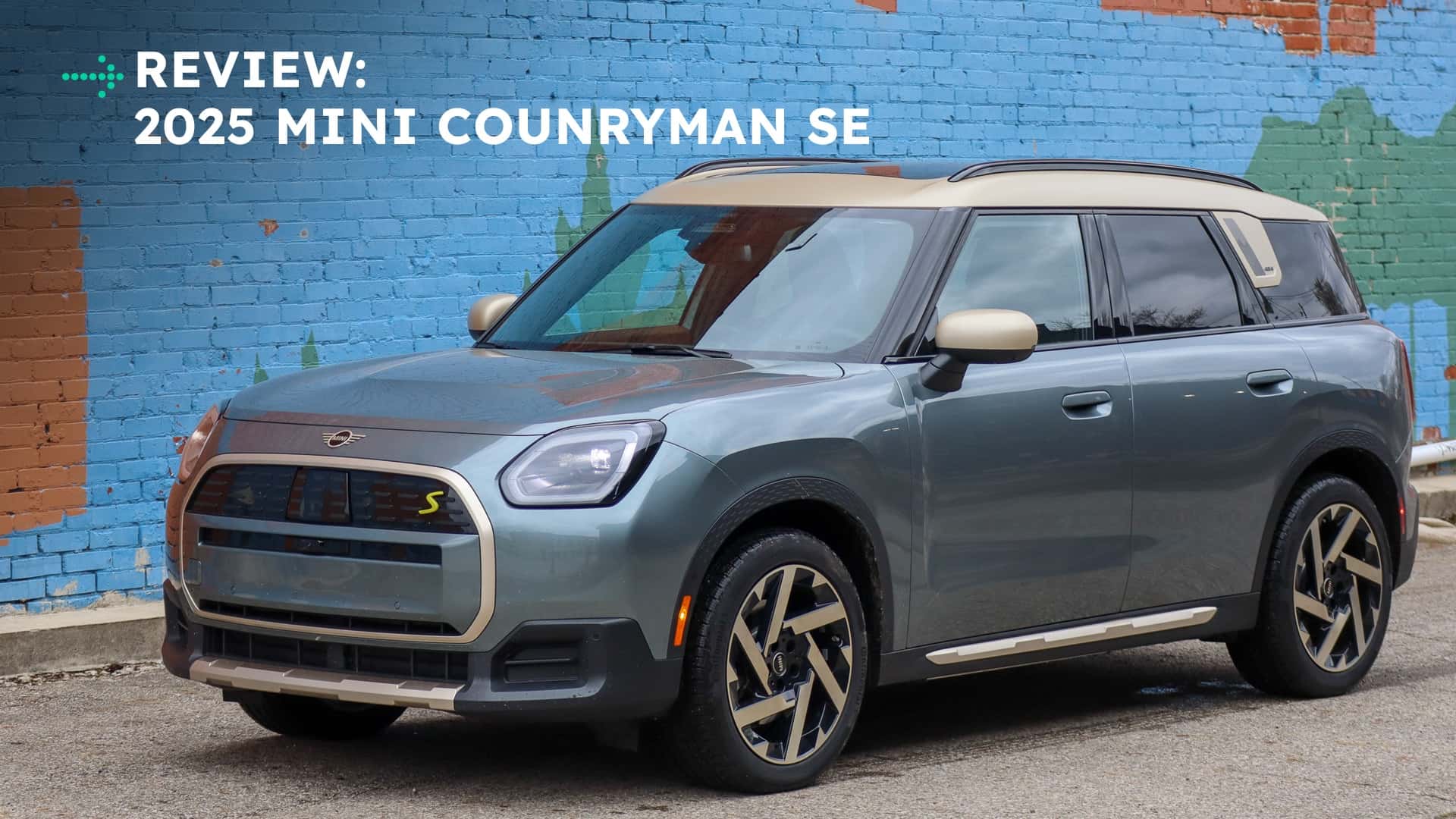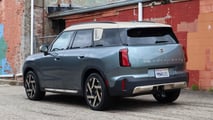
The BMW iX may be one of the ugliest cars on sale, but underneath that ugly wrapper lies quite a lovely electric car. The beaver-toothed front end and tragic proportions are hiding an interior that’s almost architectural in its ambiance, paired with a driving experience that’s sharper than some sports-oriented models from other brands. It’s a range king, too—a treat in the electric car space.
Similarly, the Mini Countryman SE has taken a lot of flak for what some people say represents everything wrong with the Mini brand. To some folks, this car is too big, too ugly, and its circular infotainment screen is way too complicated compared to the simplistic aura that classic Mini cars had. Or heck, even the early BMW-era Minis. Are they right?
I don’t know. I’m not going to pretend to be the ambassador for Mini enthusiasts and purists. But I do know that a week with the Countryman SE revealed a charming electric vehicle, even if it’s not exactly pitch-perfect in its execution.
2025 Mini Countryman SE
Gallery: 2025 Mini Countryman SE Review







What’s a Mini Countryman SE?
Believe it or not, the Mini Countryman is now in its third generation. Initially started back in 2011, this biggie-mini crossover was designed to court the number of buyers who liked the Mini Cooper hatchback, but wanted a little more space and a second set of doors. I suppose the ill-fated Clubman was also designed to satiate that desire, but its hearse-style rear doors and crew-cab door on the passenger side meant it was a five-door in the most maliciously compliant way. Mini drivers wanted a “five door” in the traditional sense, with four normal, forward-hinged doors, and a hatchback.

Some point after that, and possibly even in response, the slightly-bigger-than-Mini Countryman was born. It was an immediate sales success. Several generations later, and a healthy amount of middle-aged model bloat, the Honda Fit-sized Countryman has turned into a small crossover that’s a stone’s throw from a Toyota RAV4. Victory, it seems, has defeated the Countryman.
But while the third-generation Countryman is bigger than ever, its platform feels designed to right some of those wrongs. Underneath, the Countryman is an electrified version of its gas-powered sibling and closely related to the BMW X1. The Countryman SE’s direct electric analog is the BMW iX1, an electric version of the X1 that we don’t get here.
In Mini’s modern lineup, it’s the only four-door EV available with the Mini badge. The smaller Aceman five-door is missing in action for the U.S. market.
Power for the Countryman SE comes from two electric motors that have a combined output of 308 horsepower and 364 ft-lbs of torque. This is fed by a 64.6 kWh battery good for 212 miles of range, mounted underneath the car’s roughly 4,400-pound body. Oh, and dual-motor is the only way to fly; no front-wheel-drive-only models here.
Exterior, Interior And Controls
A lot of people don’t like the way the Mini Countryman SE looks inside or out.
I am not one of those people. I think it’s a swell-looking car, but I will admit that it’s a design that looks far better in person. This is the biggest Countryman yet, but I think the Mini designers were good at both making the familiar Mini silhouette feel fresh, while disguising the car’s physical girth.

Like other modern BMW Group cars, photos don’t really do it justice; the Mini’s sides look kind of blank and understyled, with not much brightwork or surfacing aside from the chunky, squared-off wheel arches. Yet, in person, the Countryman SE’s side surfacing is deceptively complex, with interesting surface interactions. I fell in love with the Countryman’s dead-on rear view, the beefy trunklid, and Union Jack taillights feel like such a techno-futurist elevation of what we’ve already seen on modern Minis. Add in the bronze roof and wheels, and it’s such a good way to make an old theme feel new and modern. I like it a lot more than other second-gen retro designs, like the Fiat 500e.
The interior is arguably the best part of the Countryman SE.
Similar to the exterior, the interior is deceptively fresh. At first glance, the Mini’s interior looks like little more than a makeup compact-shaped screen mounted on a plastic panel. In reality, the car’s interior is so much more complicated. The shapes are simple – this feels like a more earnest reinterpretation of the very basic dashboards of the original Morris Mini Cooper.



Yet, all of the surfaces look so much more interesting in person. All of the bright work in my tester was bronze, matched to the bronze roof and wheels. The blue fabric on the dashboard and upper levels of the doors turns orange/bronze as it moves toward the rear of the car. Add in the really nice leather seats, and the interior is so charming that you’ll forget that there aren’t very many soft-touch plastics at all. The only soft part of the interior is the seats and armrests.
Oh, and I liked the circular-shaped screen and its software, but we’ll get into that in a more focused review of the software.
Mini Countryman SE Driving Impressions
Fundamentally, the Countryman SE is a converted gas car with some batteries shoved under the floorboard.
On its face, the Countryman SE’s numbers are very average. It’s heavy, kind of tall, and its power numbers aren't as staggering as cars like the Volvo EX30 twin motor, which has more than 100 more horsepower than this Mini. Yet, this still manages to be a fun-to-drive crossover. Especially when you don’t have a Mini purist all up in your ear, complaining about how the Countryman SE is the antithesis of any Mini product.

I guess to be fair to those folks, they are a little right. I’ve driven plenty of Mini Coopers in my day, and the low-to-the-ground, slightly raw feeling is part of their appeal. The Countryman SE instead feels tall and very refined behind the wheel, not at all like the old Mini hatchbacks of yore. Dare I say it, the Countryman SE’s suspension tuning is sophisticated and feels expensive, the ride is the opposite of rough, and it feels a premium car, not a toy. For some, they’d hate it.
I am not one of those folks. Yes, the Countryman SE feels a little tall and bulkier than I’d like, and yes, I wish the suspension were a tad firmer, but the car makes up for it by being relatively engaging to drive. The steering ratio is fairly quick, and there’s a bit of feel for the type of vehicle that it is. The car corners flat and grips hard, whereas other cars with similar characteristics would not feel anywhere near as engaging. I mean, drive an Equinox EV, then hop behind the wheel of this thing.
The Countryman SE is also a quick car. Stick it in Go-Kart mode, depress the throttle to the floor, and the Mini will do its best impression of a rocket ship – it’s one of the first EVs I’ve ever driven that genuinely felt as if Mini had underrated its specifications. Mini says it’ll hit 60 in 5.4 seconds, but Car and Driver said its Countryman SE scooted to 60 mph in a mere 4.8 seconds. That’s pretty damn quick.
Charging Ability and Range

The Mini Countryman SE’s range and charging abilities seem to be, on paper, kind of mediocre. The car is only rated for 212 miles of range, but it’ll zip from 10-80% on a DC fast charger in 29 minutes, with a maximum speed of 130 kW.
These numbers would have been cutting-edge in 2018. But, to be fair to Mini, the Countryman SE actually did all of those things. Our DC fast charging test hit the 29-minute mark right on the money, while a mixed-use road trip had me on track to achieve about 190 miles of range. For some, this may not be enough miles, but for my use case, the Mini was just fine. Over the week, I averaged 3.2 miles per kWh, which is merely okay.
Frustratingly, the Mini has DC fast charging preconditioning, but it’s not intuitive to use. It can activate automatically when navigating to a DC fast charger, but I often don’t use navigation in everyday driving. There is a button to turn on the preconditioning manually, but more often than not, it was greyed out with no explanation.

Verdict
The Mini fans may have a point. On some level, the Countryman’s oversized dimensions and weird styling may not be everyone’s cup of tea. I get it, I remember being somewhat disappointed driving the new Fiat 500e compared to my old Fiat 500 Abarth.
However, I don’t think every car needs to be a direct 1-to-1 version of something old. Perhaps it’s time to reinterpret the past into something new—and take that something new, for what it is. With that in mind, the Mini Countryman SE has a lot of things to like about it. It’s sharp to drive without losing its premium edge, it is spacious for being a compact crossover, and in the grand scheme of things, it’s not even that expensive. True, the range and charging specifications are mediocre, but I think it’ll still work for most people.

I don’t even mind the price—my example stickered for $51,145. All Countryman SEs effectively come in one trim, with only a handful of option packs that can be optioned. My example came with the Iconic package ($3,200) and the Comfort Max package ($900), which added goodies like a Harmon & Kardon sound system, power front seats, and Mini’s Active Driving Assistant Pro. For comparison’s sake, this is cheaper than an AWD Cadillac Optiq. Although the Optiq qualifies for the federal $7,500 tax credit on full purchases. For now.
I just liked driving the Mini. Sometimes when I’m behind the wheel of these press cars, it can feel like a slog, like I am forcing myself to drive a car I don’t really like. Whereas with the Mini, I found myself making up reasons to drive the thing. I didn’t want to give it back. Because I liked it.
I think the world would be a better place if we drove cars we liked.
Contact the author: kevin.williams@insideevs.com







